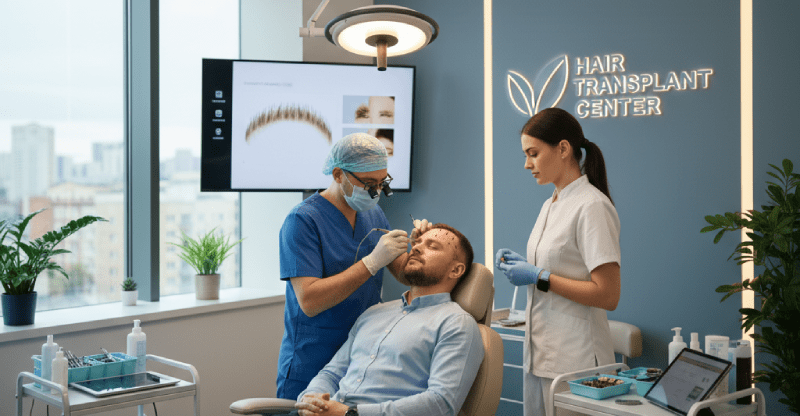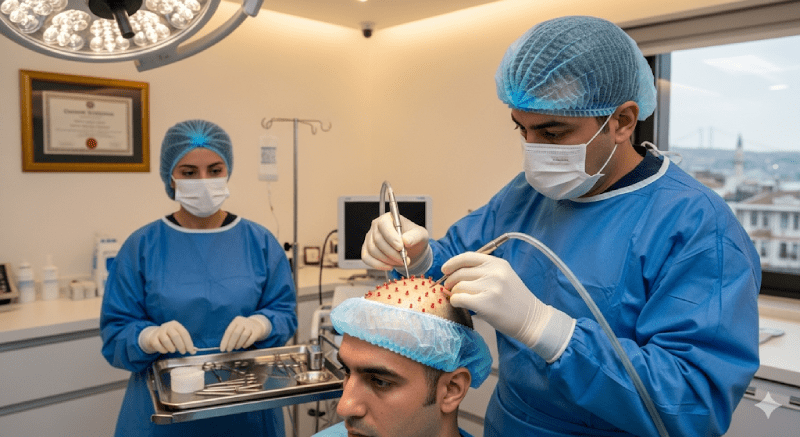What is Hair Transplantation?
Hair transplantation is the process of transplanting hair follicles taken from the back and sides of the head (donor area), which are generally resistant to genetic hair loss, to hairless or sparse areas in individuals experiencing hair loss. Since this procedure is performed with the individual’s own hair follicles, it provides a very natural and aesthetic result. Hair transplantation not only fills in bald areas but also restores the self-confidence and youthful appearance that the person has lost. The procedure is generally performed under local anesthesia, which ensures that the patient does not feel any pain during the operation.
Who is a Suitable Candidate for Hair Transplantation?
Suitable candidates for hair transplantation are individuals with a sufficient amount of healthy hair follicles in the back of the head (donor area). The best results are obtained in people whose hair loss is not caused by a disease or a temporary condition, that is, whose hair loss process has been completed. Generally, men over the age of 20 and women with thinning hair are suitable candidates for this procedure. It is essential that chronic conditions such as diabetes and heart disease in individuals are under control. The candidacy status is determined as a result of a detailed examination by a specialist.
What is the FUE Method?
FUE (Follicular Unit Extraction) is the most widely used technique in hair transplantation today. In this method, hair follicles from the donor area are extracted one by one with the help of a special micromotor or a manual tool. After the follicles are taken, micro-channels are opened in the hairless area and the follicles are carefully placed into these channels. Since the FUE method does not require surgical incisions or stitches, the risk of scarring in the donor area is very low and the recovery process is quite fast.
What is the DHI Method?
The DHI (Direct Hair Implantation) method is considered a version of the FUE technique and is performed using a special Choi implanter pen. The most important feature of this pen is that the hair follicles are implanted immediately after they are taken, simultaneously with the channel opening. This means the hair follicles spend less time outside and their engraftment rates increase. The DHI method is preferred especially in unshaven hair transplantation and in cases where a denser result is desired.
Is Hair Transplantation a Painful Procedure?
No, since the hair transplantation procedure is performed under local anesthesia, the patient does not feel any pain. The anesthesia numbs both the donor area where the hair follicles will be taken and the area to be transplanted. The patient remains awake during the procedure and can listen to music or watch a movie. There may be a slight ache or feeling of tightness after the operation, which can be easily controlled with painkillers prescribed by the doctor.
How Long Does Hair Transplantation Take?
The duration of the hair transplantation operation varies depending on the number of hair follicles (grafts) to be transplanted, the method to be used, and the experience of the hair transplantation center. Generally, an average operation can take between 4 and 8 hours. If a large area is to be transplanted or more follicles are to be taken, this period may be longer. Short breaks are given during the operation for the patient’s comfort.

What Factors Affect Hair Transplantation Prices?
Hair transplantation prices vary depending on many factors. The most important factors include the number of hair follicles to be transplanted, the technique to be used (FUE, DHI), the experience of the team performing the operation, the location of the clinic, and additional services offered with the operation (accommodation, transfer, etc.). To get a definitive price, it is necessary to be examined by a specialist and have a personal treatment plan created.
What is Shock Loss in Hair Transplantation?
After hair transplantation, a large portion of the transplanted hairs fall out within the first 1-3 months. This is called “shock loss” and is a natural part of the transplantation process. The hair follicles do not fall out, only the hair shafts. Shock loss occurs for the follicles to adapt to their new location and prepare to produce new, stronger hair shafts. After this process, the hair begins to grow permanently.
Are the Results of Hair Transplantation Permanent?
Yes, the results of hair transplantation are permanent. This is because the hair follicles taken for transplantation are genetically resistant to hair loss. These follicles retain their characteristics and do not fall out when they are transplanted to their new location. This is the most important feature that distinguishes hair transplantation from other hair restoration methods. The transplanted hairs stay with you for a lifetime and continue to grow like natural hair.
Do Scars Remain After the Operation?
Thanks to modern techniques like FUE and DHI used today, almost no scars remain in the donor area. In these methods, since the hair follicles are taken one by one, the micro-wounds that occur heal within a few days and leave unnoticeable scars. However, in FUT, an older method, a strip-shaped incision is made, leaving a permanent scar in the donor area.
What Should Be Considered Before Hair Transplantation?
What should be considered before the hair transplantation procedure is very important for the success of the operation. The use of blood-thinning medications and alcohol should be stopped at least one week before the procedure. Smoking also negatively affects the healing process, so it should be quit at least two weeks before and after the operation. If you regularly use medications, you must inform your doctor about this. The hair should be washed one day before the operation and you should come to the procedure clean.
What is the Recovery Process Like After Hair Transplantation?
The recovery process varies from person to person, but it generally includes the most intense period in the first few days. It is normal to see slight redness, swelling, and scabbing in the transplanted area and the donor area. The scabs usually fall off within 10-15 days. Complete healing and hair growth can take several months. It is important to avoid physical activities and sunlight for the first month.
When Can I Return to Work?
The time to return to work depends on the type of work and the person’s recovery speed. Those who work in an office job can usually return to work within 2-3 days. However, for those who work in a physically strenuous or outdoor job, this period can be a week or more. Since there may be swelling and scabbing in the first few days, the decision to return to social life is personal.
When Do the Transplanted Hairs Grow Out?
The growth of transplanted hair is a gradual process. After the shock loss phase, the hair begins to grow slowly starting from the 3rd month. A noticeable change and density are observed in the 6th month. It is necessary to wait 1 year for the full and final result. During this period, the hair thickens and gains its natural appearance.
What Should Be Considered After Hair Transplantation?
In the first few days after the operation, it is very important not to touch the transplanted area and to lie on your back. Special shampoo and lotions recommended by the doctor should be used. For the first 10 days, the hair should be washed gently, and impacts should be avoided. Heavy sports and strenuous exercises should be avoided for the first month. Staying away from alcohol and smoking speeds up the healing process.
Who Cannot Have Hair Transplantation?
Hair transplantation is generally not applied to individuals with heart and blood pressure diseases, blood clotting disorders such as hemophilia, active skin infections, or those undergoing cancer treatment. Also, it is not a suitable method for individuals who do not have enough hair follicles in the donor area or whose hair loss process has not been completed. Such conditions can negatively affect the success and safety of the procedure.

Is Sexual Intercourse Forbidden After Hair Transplantation?
It is recommended to refrain from sexual intercourse for the first 1 week after the hair transplantation operation. Sexual activity can increase heart rate and blood pressure, which can raise the risk of bleeding in the operation area. Therefore, it is important to follow this rule for the transplanted hair follicles to not be damaged and for the healing process to proceed healthily.
How Does Gastric Botox Work?
Gastric botox works by slowing down the movement of the stomach muscles. This slowdown prolongs the stomach’s emptying time. This causes the person to experience a longer feeling of fullness. At the same time, the satiety signals sent to the brain become stronger, and the person eats less. Thanks to this mechanism, calorie intake decreases and the weight loss process begins.
What is the Best Season for Hair Transplantation?
Hair transplantation can be performed successfully in any season. However, since direct sunlight should be avoided for the first few weeks after the procedure, the autumn, winter, or spring months can offer a more comfortable recovery process. Nevertheless, the operation can also be performed in the summer months, but more attention should be paid to precautions such as sun protection and wearing a hat.
How Many Grafts Can Be Transplanted?
The number of grafts that can be transplanted depends entirely on the density and quality of the donor area. The healthier and denser the donor area, the more grafts can be taken. In a single session, hair transplantation can usually be done between 3000 and 5000 grafts. This number varies according to the size of the patient’s hairless area and the desired density.
When Can I Wash My Hair After Hair Transplantation?
The first wash after hair transplantation is usually done 2 or 3 days later and is performed by a specialized team at the hair transplantation center. This wash is done with a special lotion and shampoo, very gently, without damaging the transplanted area. The patient is given detailed instructions on how to perform subsequent washes.
Can Hair Be Transplanted from Beard or Body Hair?
Yes, in individuals with insufficient hair follicle donor area, beard or body hair (such as chest, back) can also be used for hair transplantation. This method is called BHT (Body Hair Transplant). Beard hairs are usually preferred first because they are thick and dense. However, it should be noted that body hairs have different growth cycles compared to head hair.
Can Hair Transplantation Fail?
The hair transplantation procedure can fail if not done correctly. The most common causes of failure include incorrect hair follicle extraction, damage to the follicles, improper channel opening, or not following post-operative instructions. Operations performed by an experienced surgeon and team significantly increase the success rate.
Do Scars Remain After Hair Transplantation?
After hair transplantation, especially with the FUE and DHI methods, no visible scars remain. The micro-scars that form in the donor area completely close as the hair grows. However, if hygiene is not paid attention to after the operation or if wound healing is problematic, small scars may occur. Modern techniques are designed to minimize scar formation.
Are Only Hair Follicles Transplanted in Hair Transplantation?
Yes, in the hair transplantation procedure, only hair follicles (follicular units) are used. Hair transplantation is the transplantation of hair follicles, not hair shafts. Follicular units are small tissue fragments containing one or more hair shafts, and these are collected from the donor area and transferred to the area to be transplanted.
What is the Difference Between Hair Transplantation and Hair Prosthesis?
Hair transplantation is a permanent surgical procedure performed with the person’s own hair follicles. A hair prosthesis, on the other hand, is a temporary and non-surgical solution where artificial hair is attached to the hairless area with a special adhesive. While hair transplantation offers a natural appearance, a hair prosthesis requires constant maintenance and renewal.
Is There an Age Limit for Hair Transplantation?
The minimum age limit for hair transplantation is 20 years and older, when hair loss is not associated with a disease and the hair loss pattern has become clear. However, this age range can change depending on the person’s hair loss type and course. As for the upper age limit, there is none as long as the person’s general health status is good.
Can Hair Transplantation Be Done on Women?
Yes, hair transplantation can also be done on women. However, since hair loss in women is usually a widespread thinning rather than a regional one, not every woman may be a candidate. Shaveless hair transplantation methods like DHI are more frequently preferred by women.
Do Swelling and Bruising Occur After Hair Transplantation?
Yes, it is normal to see mild to moderate swelling and bruising after a hair transplantation operation. This swelling usually increases within the first 2-3 days and then gradually decreases. Bruises that form in the forehead area or around the eyes also disappear on their own within a few days. A cold compress can be applied for the first 48 hours after the operation to reduce swelling and bruising.



